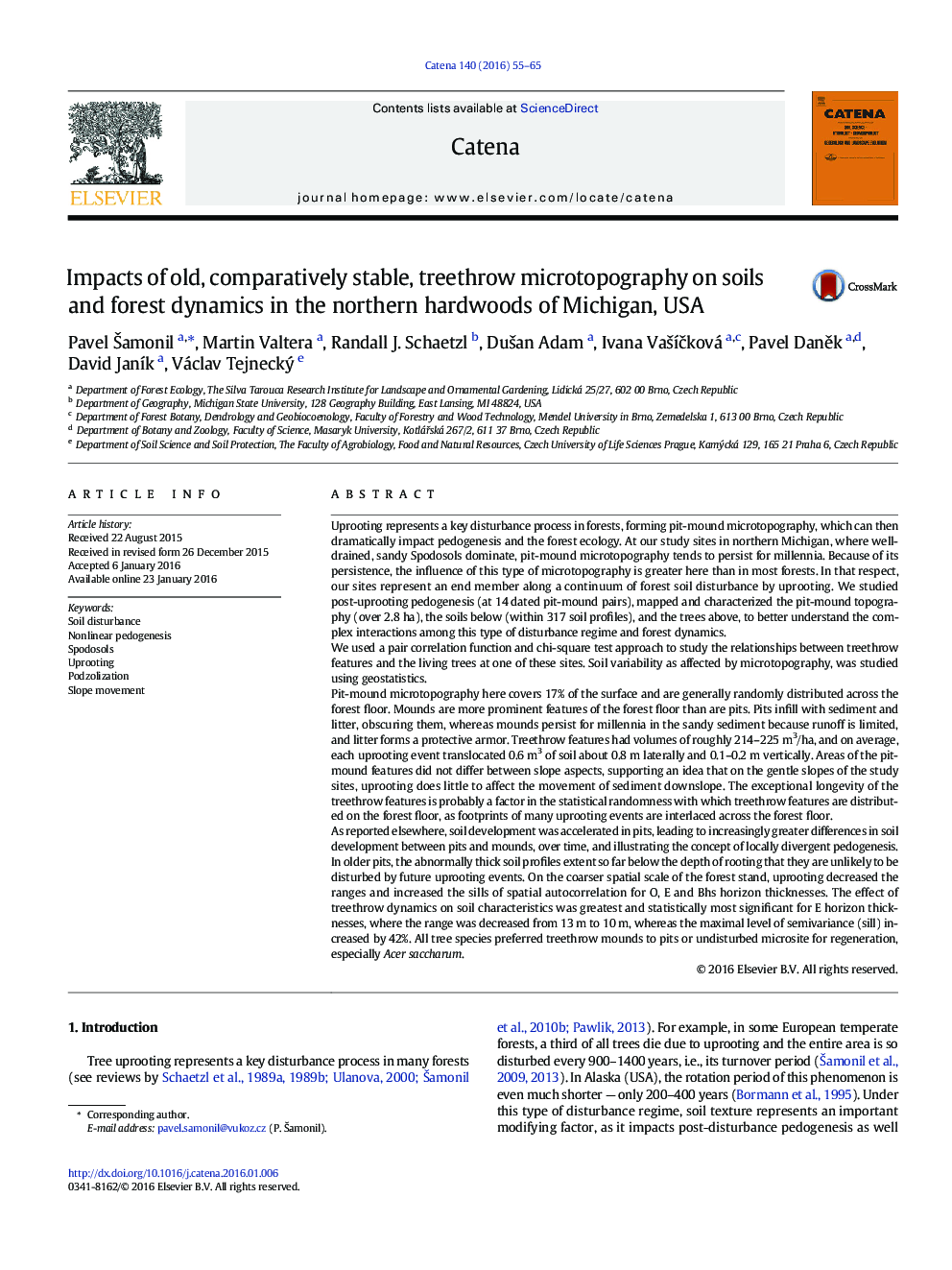| کد مقاله | کد نشریه | سال انتشار | مقاله انگلیسی | نسخه تمام متن |
|---|---|---|---|---|
| 4570918 | 1629212 | 2016 | 11 صفحه PDF | دانلود رایگان |
• Tree uprooting can cause divergent soil evolution at local (pedon) scales.
• Uprooting on gentle slopes does little to move sediment downslope.
• Treethrow leads to increased soil variability and decreased ranges of autocorrelation.
• Uprooting features were randomly distributed.
• Acer saccharum appeared to have the closest correlation to microsites (mounds).
Uprooting represents a key disturbance process in forests, forming pit-mound microtopography, which can then dramatically impact pedogenesis and the forest ecology. At our study sites in northern Michigan, where well-drained, sandy Spodosols dominate, pit-mound microtopography tends to persist for millennia. Because of its persistence, the influence of this type of microtopography is greater here than in most forests. In that respect, our sites represent an end member along a continuum of forest soil disturbance by uprooting. We studied post-uprooting pedogenesis (at 14 dated pit-mound pairs), mapped and characterized the pit-mound topography (over 2.8 ha), the soils below (within 317 soil profiles), and the trees above, to better understand the complex interactions among this type of disturbance regime and forest dynamics.We used a pair correlation function and chi-square test approach to study the relationships between treethrow features and the living trees at one of these sites. Soil variability as affected by microtopography, was studied using geostatistics.Pit-mound microtopography here covers 17% of the surface and are generally randomly distributed across the forest floor. Mounds are more prominent features of the forest floor than are pits. Pits infill with sediment and litter, obscuring them, whereas mounds persist for millennia in the sandy sediment because runoff is limited, and litter forms a protective armor. Treethrow features had volumes of roughly 214–225 m3/ha, and on average, each uprooting event translocated 0.6 m3 of soil about 0.8 m laterally and 0.1–0.2 m vertically. Areas of the pit-mound features did not differ between slope aspects, supporting an idea that on the gentle slopes of the study sites, uprooting does little to affect the movement of sediment downslope. The exceptional longevity of the treethrow features is probably a factor in the statistical randomness with which treethrow features are distributed on the forest floor, as footprints of many uprooting events are interlaced across the forest floor.As reported elsewhere, soil development was accelerated in pits, leading to increasingly greater differences in soil development between pits and mounds, over time, and illustrating the concept of locally divergent pedogenesis. In older pits, the abnormally thick soil profiles extent so far below the depth of rooting that they are unlikely to be disturbed by future uprooting events. On the coarser spatial scale of the forest stand, uprooting decreased the ranges and increased the sills of spatial autocorrelation for O, E and Bhs horizon thicknesses. The effect of treethrow dynamics on soil characteristics was greatest and statistically most significant for E horizon thicknesses, where the range was decreased from 13 m to 10 m, whereas the maximal level of semivariance (sill) increased by 42%. All tree species preferred treethrow mounds to pits or undisturbed microsite for regeneration, especially Acer saccharum.
Figure optionsDownload as PowerPoint slide
Journal: CATENA - Volume 140, May 2016, Pages 55–65
